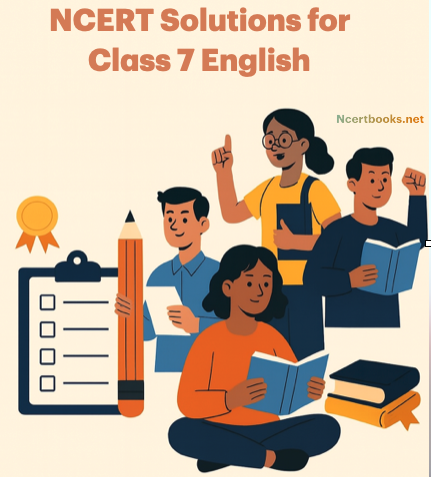NCERT Solutions for Class 7 English (Poorvi) gives you clean, chapter-wise answers written in simple language and aligned with the latest CBSE syllabus issued by the National Council of Educational Research and Training. Each unit below begins with a short overview so you know the focus and skills (reading, vocabulary, grammar-in-context, reference-to-context, and writing). Use the tables to jump directly to the chapter solutions, practice sheets, and PDFs.

Table of Contents
| Section | What You’ll Find | Jump |
|---|---|---|
| Poorvi – Class 7 English (New Syllabus) | Five themed units with chapter-wise solutions and practice | Open |
| Reading | Writing | Grammar | Unseen passages, short & long compositions, and key grammar topics | Open |
| Old Syllabus (Reference) | Honeycomb (prose, poems) and An Alien Hand (supplementary) | Open |
| Also Read | Notes, MCQs, worksheets, and full Class 7 resources | Open |
| FAQs | Downloads, exam tips, and answer-writing frames | Open |
NCERT Class 7 English – Poorvi Book: Unit-wise Solutions
Unit 1 – Learning Together
This unit builds teamwork, resilience, and reflective reading. You will practise identifying the central idea, tracking the narrator’s feelings, and answering reference-to-context (RTC) questions with a quote → idea → inference pattern. The poem teaches perseverance through sound devices (rhyme, repetition), while the prose piece on “seeing” strengthens theme, tone, and figure-of-speech spotting. Writing tasks include short reflections and diary entries. For quick scoring, keep answers structured: context in one line, two key points with text evidence, and a concluding value statement that links to “learning together”.
Unit 2 – Wit and Humour
Humour arrives through situation, exaggeration, and word-play. You’ll learn to locate the exact line that creates humour, explain how tone shifts, and choose precise words for short answers. The poem nudges you to observe people and use connotative meanings. For 3-markers, write cause → funny effect → message. Creative tasks include comic dialogues and character sketches that keep language polite and classroom-appropriate.
Unit 3 – Dreams and Discoveries
Innovation, imagination, and exploration are the heart of this unit. You will link cause and effect in an invention story, interpret symbolic images in poetry, and comprehend factual passages on geography. Answers should balance creativity with accuracy—state the idea, support it with a line or detail, and end with a realistic application. Writing practice includes process paragraphs (“How something works”) and short descriptive pieces.
Unit 4 – Travel and Adventure
Adventurous narratives push you to map settings, track suspense, and write crisp action lines. The travel poem sharpens observation and metaphor recognition. The “summit” chapter leads to motivational writing. For exam-style 5-markers, use the frame: context → two scene details with evidence → lesson or message. RTC answers must identify the speaker/situation and then explain the key idea in two short lines.
Unit 5 – Bravehearts
This unit honours courage and service. You will read tributes, letters, and a historical sketch. Focus on tone (respectful, grateful), formal vocabulary, and structuring longer answers: introduction of the person/event, two fact-backed qualities, and a concluding value. Writing tasks include messages of gratitude and brief biographical paragraphs using dates and places correctly.
Reading • Writing • Grammar – Class 7 English
CBSE Class 7 English – Reading (Unseen Passages)
CBSE Class 7 English – Writing
| Category | Topics | Open |
|---|---|---|
| Short Composition | Message Writing • Notice Writing • Postcard Writing | Templates + Samples |
| Long Composition | Paragraph Writing • Paragraph (Verbal Input) • Paragraph (Visual Input) • Article • Speech • Letter • Application • Email • Story | Models + Checklists |
CBSE Class 7 English – Grammar
| Topic | What You’ll Master | Open |
|---|---|---|
| The Sentence | Kinds, subject–predicate, fragments vs run-ons | Practice |
| Pronouns and Possessive Adjectives | Types, agreement, case | Practice |
| The Parts of Speech | Noun, pronoun, verb, adjective, adverb, preposition, conjunction, interjection | Practice |
| Verb & Tenses | Simple/Continuous/Perfect; sequence of tenses | Practice |
| Articles | a/an/the with exceptions | Practice |
| Agreement of Verb and Subject | Compound subjects, quantities, intervening phrases | Practice |
| Active and Passive Voice | Transformations, tense care | Practice |
| Reported Speech | Statements, questions, commands, time expression changes | Practice |
| Word Power & Modals | Collocations, phrasal verbs, can/could/may/might/should/must | Practice |
| Integrated Exercises | Mixed grammar in context |
Old Syllabus – Reference Sets
NCERT Solutions for Class 7 English – Honeycomb (Prose)
| Chapter | Open |
|---|---|
| Three Questions | Solutions |
| A Gift of Chappals | Solutions |
| Gopal and the Hilsa Fish | Solutions |
| The Ashes that Made Trees Bloom | Solutions |
| Quality | Solutions |
| Expert Detectives | Solutions |
| The Invention of Vita – Wonk | Solutions |
| Fire Friend and Foe | Solutions |
| A Bicycle in Good Repair | Solutions |
| The Story of Cricket | Solutions |
NCERT Solutions for Class 7 English – Honeycomb (Poetry)
NCERT Solutions for Class 7 English – An Alien Hand (Supplementary)
Also Read
| Resource | What You’ll Get | Open |
|---|---|---|
| Class 7 English Extra Questions (Poorvi) | Chapter-wise practice with RTC and long answers | Open |
| Class 7 English MCQ (Poorvi) | Objective tests for quick self-check | Open |
| Class 7 English Notes (Summary) | One-page summaries, themes, devices | Open |
| Poorvi Class 7 Worksheet | Printable worksheets with answer keys | Download |
| NCERT Solutions For Class 7 (All Subjects) | Maths, Science, SST, Hindi, English | Browse |
| NCERT Books For Class 7 | Official free PDFs for offline use | Download |